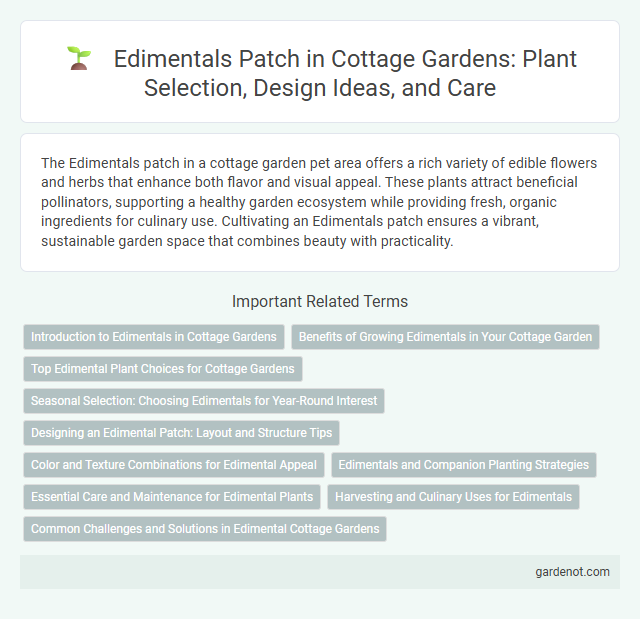The Edimentals patch in a cottage garden pet area offers a rich variety of edible flowers and herbs that enhance both flavor and visual appeal. These plants attract beneficial pollinators, supporting a healthy garden ecosystem while providing fresh, organic ingredients for culinary use. Cultivating an Edimentals patch ensures a vibrant, sustainable garden space that combines beauty with practicality.
Introduction to Edimentals in Cottage Gardens
Edimentals in cottage gardens combine edible and ornamental plants, creating a harmonious blend that enhances biodiversity and seasonal interest. Incorporating herbs, flowers, and unique edible leaves like sorrel, borage, and nasturtium maximizes both culinary and aesthetic value in limited garden spaces. This approach supports sustainable gardening by attracting pollinators and providing fresh, homegrown ingredients year-round.
Benefits of Growing Edimentals in Your Cottage Garden
Growing edimentals in your cottage garden enhances biodiversity by attracting pollinators and beneficial insects, promoting a healthier ecosystem. These nutrient-rich, edible plants provide a sustainable source of fresh herbs and vegetables, reducing reliance on store-bought produce while increasing garden productivity. Incorporating edimentals also improves soil health through natural nutrient cycling and supports organic gardening practices.
Top Edimental Plant Choices for Cottage Gardens
Top edimental plant choices for cottage gardens include borage (Borago officinalis), known for its cucumber-flavored leaves that enhance salads and beverages with a vibrant, star-shaped blue flower. Nasturtium (Tropaeolum majus) offers peppery-tasting flowers and leaves, providing both color and edible garnish while attracting beneficial pollinators. Sorrel (Rumex acetosa) brings a lemony tang to dishes and thrives in shady spots, making it a versatile, nutrient-rich addition to any cottage garden patch.
Seasonal Selection: Choosing Edimentals for Year-Round Interest
Seasonal selection in an edimentals patch ensures a dynamic display of edible and ornamental plants throughout the year, balancing early spring greens like sorrel and wild garlic with summer herbs such as lemon balm and basil. Autumn brings robust flavors from edible chrysanthemums and late-season sorrels, while winter offerings include hardy plants like sea kale and horseradish, providing both nutrition and garden structure. Carefully planning plant varieties based on their growth cycles and harvest times maximizes the patch's visual appeal and culinary value across all seasons.
Designing an Edimental Patch: Layout and Structure Tips
Designing an Edimental patch involves strategically arranging edible and ornamental plants to maximize both aesthetic appeal and functionality. Incorporate a variety of textures, colors, and growth habits, such as nesting herbs like chives and oregano alongside vibrant flowering plants like nasturtiums to enhance visual interest and pollinator attraction. Utilize layering techniques by planting taller species like borage or fennel at the back and ground-covering edibles such as strawberries at the front to optimize space and create a balanced, productive garden layout.
Color and Texture Combinations for Edimental Appeal
The Edimentals patch thrives in cottage gardens by showcasing vibrant color palettes and diverse textures that attract pollinators and enhance visual interest. Blending rich reds, deep purples, and bright yellows with varied leaf shapes and surfaces creates a dynamic, edible landscape. This interplay of hues and textures not only elevates the garden's aesthetic but also supports a sustainable, flavorful harvest.
Edimentals and Companion Planting Strategies
Edimentals patch in a cottage garden integrates edible plants with ornamental species, enhancing biodiversity and nutrient cycling. Companion planting strategies optimize growth by pairing edibles like herbs and vegetables with flowers that attract beneficial insects, reducing pests naturally. This synergy supports sustainable gardening practices while maximizing both yield and aesthetic appeal.
Essential Care and Maintenance for Edimental Plants
Edimental plants require well-drained soil enriched with organic compost to promote healthy growth and abundant yields. Regular pruning and harvesting encourage continuous production while preventing overcrowding and disease. Consistent watering tailored to the plant's specific moisture needs ensures optimal flavor and vitality throughout the growing season.
Harvesting and Culinary Uses for Edimentals
Harvesting Edimentals in a cottage garden requires careful timing to ensure optimal flavor and nutrient content, typically when leaves and flowers are young and tender. Culinary uses of Edimentals include fresh salads, herbal teas, and garnishes that enhance both taste and visual appeal with their vibrant colors and unique textures. Incorporating these plants into everyday meals boosts nutritional value and introduces distinctive flavors, making them a versatile addition to any home garden.
Common Challenges and Solutions in Edimental Cottage Gardens
Common challenges in edimental cottage gardens include pest infestations, soil nutrient imbalance, and unpredictable weather conditions. Implementing integrated pest management, using organic compost to enrich soil, and selecting resilient plant varieties help mitigate these issues. Regular monitoring and adaptive care ensure the health and productivity of the edimental patches.
Edimentals patch Infographic

 gardenot.com
gardenot.com